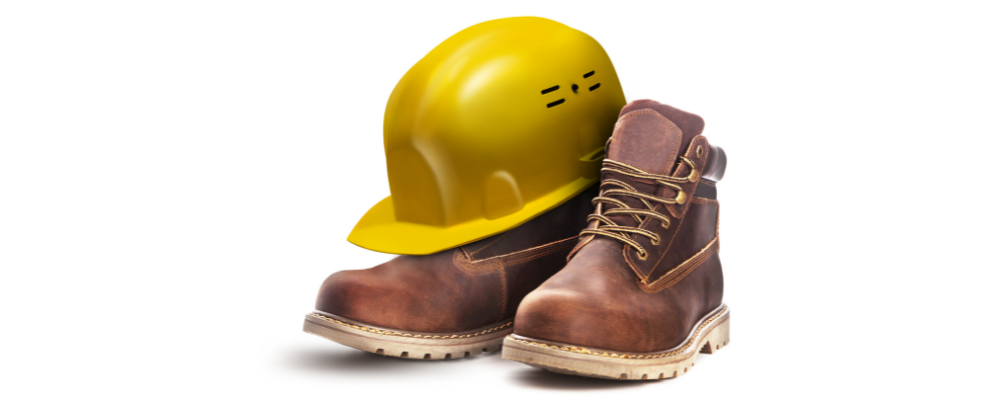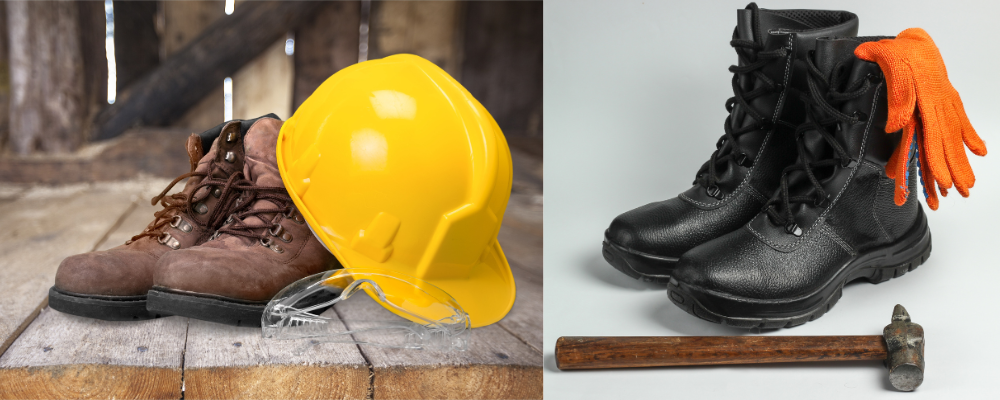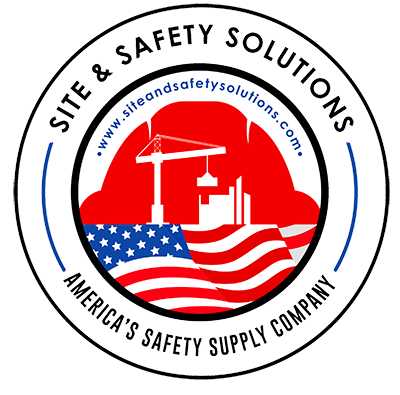
Introduction
Construction work demands footwear that goes beyond comfort and style. The proper work boots offer protection and ensure safety and productivity on the job site. This comprehensive guide delves into the essential features of work boots and highlights the top picks every construction worker should consider.
Understanding the Importance of Work Boots in Construction
Construction sites are rife with hazards, making appropriate footwear a critical aspect of personal safety. Work boots are engineered to shield against various risks:
Protection Against Impact and Compression
Construction sites are hazardous environments where heavy objects and machinery pose risks to workers’ feet. Work boots equipped with steel toe caps, such as the Men’s Thorogood Work Boot 8″ Steel Toe Wedge Sole, serve as a vital shield against these dangers. This advanced technology fortifies the footwear with a sturdy steel cap strategically placed in the toe area.
The primary function of the steel toe cap is to safeguard against the impact of heavy objects and compression forces. In the event of an accidental crash or compression, these boots provide a protective barrier, reducing the risk of severe injuries or fractures. Construction workers can confidently navigate their tasks, knowing this durable and reliable technology shields their feet.
-
Resistance to Punctures and Penetration: Protector Boot 43/10 S1P
Sharp objects and debris littered across construction sites constantly threaten workers’ feet. The Protector Boot 43/10 S1P is precisely engineered to mitigate these risks by featuring puncture-resistant soles. Constructed using robust materials and innovative design, these boots effectively shield against punctures and penetration from sharp objects.
By incorporating puncture-resistant soles, these boots significantly reduce the potential for foot injuries caused by stepping on nails, shards, or other hazardous materials commonly found on construction sites. Workers benefit from enhanced safety and reduced downtime due to foot-related injuries, allowing them to focus on their tasks with peace of mind.
-
Water and Heat Resistance: Portwest Monsal Hiker Boots S3 WP HRO
Construction work often exposes individuals to diverse weather conditions and surfaces that emit heat. The Portwest Monsal Hiker Boots S3 WP HRO addresses these challenges by offering exceptional waterproof and heat-resistant properties.
These boots are designed to repel water, keeping workers’ feet dry and comfortable even in wet or rainy conditions. Moreover, their heat-resistant nature allows workers to navigate hot surfaces encountered on construction sites without compromising comfort or safety. This feature is crucial in preventing burns or discomfort caused by exposure to elevated temperatures.
Workers relying on the Portwest Monsal Hiker Boots S3 WP HRO benefit from a versatile and protective footwear solution suitable for the varying demands of construction environments, ensuring safety and comfort throughout their tasks.
Choosing the Right Work Boots
Construction workers must consider several factors when selecting suitable work boots:
-
Comfort and Fit
Men’s Thorogood 8″ Steel Toe Moc Toe Wedge Sole Boot (U.S.A.): Known for comfort and a secure fit, these boots provide both style and functionality.
-
Durability and Longevity
Look for boots made from robust materials like high-grade leather or synthetic materials, ensuring they withstand the rigors of the construction environment.

Safety Standards Compliance
Construction sites present many hazards, emphasizing the importance of protective gear, especially work boots. Safety standards serve as crucial benchmarks in ensuring the reliability and efficacy of these boots in safeguarding workers. The ASTM, or the American Society for Testing and Materials, is among the most recognized and respected standards.
Understanding ASTM Standards
ASTM International is a globally renowned organization that develops and publishes technical standards for various materials, products, systems, and services. The ASTM establishes rigorous guidelines for work boots that manufacturers must meet to ensure the reliability and performance of their products in hazardous environments like construction sites.
Critical Components of ASTM Standards for Work Boots
- Impact Resistance (ASTM F2412-18a and ASTM F2413-18): These standards dictate footwear’s testing methods and requirements to withstand impact and compression. The ASTM assesses the footwear’s ability to protect against falling or rolling objects, ensuring the toes remain intact and unharmed.
- Electrical Hazard Resistance (ASTM F2412-18a and ASTM F2413-18): Boots compliant with these standards provide insulation against electrical hazards, reducing the risk of electric shock or injury due to live circuits or wires encountered on construction sites.
- Puncture Resistance (ASTM F2412-18a and ASTM F2413-18): Boots undergo testing to assess their capability to withstand penetration from sharp objects, such as nails or debris, reducing the likelihood of injuries caused by punctures.
- Compression Resistance (ASTM F2412-18a and ASTM F2413-18): ASTM standards evaluate the footwear’s ability to endure compression forces, safeguarding the foot from potential injuries caused by heavy objects or equipment.
Why Compliance Matters for Construction Workers
Ensuring that work boots comply with ASTM standards is not just a matter of regulatory adherence; it directly impacts the safety and well-being of construction workers. Compliance signifies that the shoes have undergone rigorous testing and meet specific criteria for protection against common hazards encountered on construction sites.
Benefits of Choosing ASTM-Compliant Work Boots
- Enhanced Protection: Compliance ensures that the boots offer reliable protection against impact, compression, punctures, and electrical hazards, minimizing the risk of workplace injuries.
- Reliability and Quality Assurance: Boots adhering to ASTM standards signify quality and reliability, giving workers confidence in their footwear’s ability to withstand job site risks.
- Regulatory Adherence: Many construction sites mandate adherence to ASTM standards for personal protective equipment, making compliant boots a prerequisite for entry and work on site.
In conclusion, prioritizing work boots that comply with ASTM standards is a non-negotiable aspect of ensuring the safety and well-being of construction workers. Adherence to these standards guarantees that the chosen footwear meets stringent criteria for protection against prevalent hazards, fostering a safer working environment.

1. Proper Care and Maintenance of Work Boots
- Cleaning Techniques: Detailed steps to clean different types of work boots, considering materials like leather or synthetic fabrics.
- Conditioning and Waterproofing: Guidance on conditioning boots to maintain their quality and tips for enhancing their waterproof properties.
- Storage and Drying: Best practices for storing and drying work boots to prevent mold, odors, and deterioration.
Details: Construction workers heavily rely on their work boots, and proper care ensures longevity and sustained performance. Regular cleaning, conditioning, and correct storage methods can significantly extend the life of these essential pieces of equipment, saving both money and potential injury risks on the job.
2. Work Boot Safety Standards and Certifications
- I understand ASTM Ratings: Explanation of American Society for Testing and Materials (ASTM) safety ratings and what each classification signifies.
- Compliance Requirements: Detailed overview of the safety standards and regulations that work boots must meet for construction site use.
- Impact of Non-Compliance: Highlighting the potential risks and consequences of wearing non-compliant or substandard work boots on job sites.
Details: Construction workers must comprehend safety standards and certifications to make informed choices. Knowing the significance of ASTM ratings and other compliance measures ensures they select boots that provide adequate protection against daily hazards.
3. Work Boot Features for Specialized Construction Tasks
- Electrical Hazard Resistance: Explanation of EH-rated boots and their significance for workers dealing with electrical components or installations.
- Insulated Boots: Describing the benefits of insulated boots for construction workers in colder climates or environments.
- Slip-Resistant Soles: Detailing the importance of slip-resistant soles, especially for workers in areas prone to spills, wet conditions, or oily surfaces.
Details: Different construction tasks demand specific features in work boots. Understanding these specialized features ensures workers can match their footwear to the hazards they encounter, thereby enhancing safety and efficiency on the job.
4. Ergonomic Design and Comfort in Work Boots
- Anatomy of Comfortable Boots: Breakdown of the features that contribute to the comfort of work boots, such as cushioned insoles, arch support, and breathable materials.
- Impact on Productivity: Discussing the correlation between comfortable footwear and increased productivity in construction work.
- Choosing the Right Fit: Tips and guidelines for selecting work boots that prioritize both safety and comfort.
Details: Comfortable work boots are not just a luxury but a necessity for construction workers. Explaining the ergonomic design principles and emphasizing the impact on productivity can help workers make informed decisions when purchasing their footwear.
These topics delve deeper into various aspects of work boots, providing valuable insights to construction workers on maintenance, safety standards, specialized features, and the importance of comfort.
For more information, visit our website and Facebook page.
For more products, visit our website :
Portwest Monsal Hiker Boots S3 WP HRO
Men’s Thorogood Work Boot 8″ Steel Toe Wedge Sole
Men’s Thorogood 8″ Steel Toe Moc Toe Wedge Sole Boot (U.S.A.)
Conclusion:
Investing in high-quality work boots is a non-negotiable aspect of a construction worker’s gear. The Protector Boot 43/10 S1P, Portwest Monsal Hiker Boots S3 WP HRO, Men’s Thorogood Work Boot 8″ Steel Toe Wedge Sole, and Men’s Thorogood 8″ Steel Toe Moc Toe Wedge Sole Boot (U.S.A.) are exemplary choices meeting the stringent demands of construction sites.
Remember, prioritizing safety and functionality in work boots ensures peace of mind and enhances productivity during strenuous construction tasks.









